Li Su
Whole-brain Transferable Representations from Large-Scale fMRI Data Improve Task-Evoked Brain Activity Decoding
Jul 30, 2025Abstract:A fundamental challenge in neuroscience is to decode mental states from brain activity. While functional magnetic resonance imaging (fMRI) offers a non-invasive approach to capture brain-wide neural dynamics with high spatial precision, decoding from fMRI data -- particularly from task-evoked activity -- remains challenging due to its high dimensionality, low signal-to-noise ratio, and limited within-subject data. Here, we leverage recent advances in computer vision and propose STDA-SwiFT, a transformer-based model that learns transferable representations from large-scale fMRI datasets via spatial-temporal divided attention and self-supervised contrastive learning. Using pretrained voxel-wise representations from 995 subjects in the Human Connectome Project (HCP), we show that our model substantially improves downstream decoding performance of task-evoked activity across multiple sensory and cognitive domains, even with minimal data preprocessing. We demonstrate performance gains from larger receptor fields afforded by our memory-efficient attention mechanism, as well as the impact of functional relevance in pretraining data when fine-tuning on small samples. Our work showcases transfer learning as a viable approach to harness large-scale datasets to overcome challenges in decoding brain activity from fMRI data.
Exploring Hallucination of Large Multimodal Models in Video Understanding: Benchmark, Analysis and Mitigation
Mar 25, 2025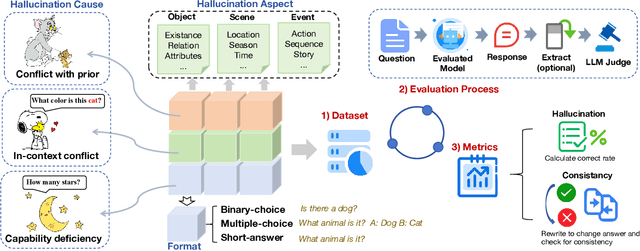
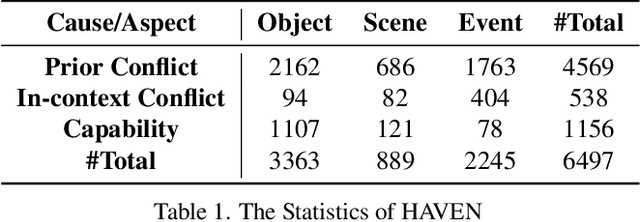

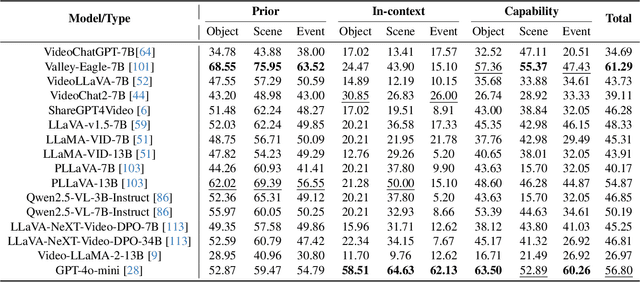
Abstract:The hallucination of large multimodal models (LMMs), providing responses that appear correct but are actually incorrect, limits their reliability and applicability. This paper aims to study the hallucination problem of LMMs in video modality, which is dynamic and more challenging compared to static modalities like images and text. From this motivation, we first present a comprehensive benchmark termed HAVEN for evaluating hallucinations of LMMs in video understanding tasks. It is built upon three dimensions, i.e., hallucination causes, hallucination aspects, and question formats, resulting in 6K questions. Then, we quantitatively study 7 influential factors on hallucinations, e.g., duration time of videos, model sizes, and model reasoning, via experiments of 16 LMMs on the presented benchmark. In addition, inspired by recent thinking models like OpenAI o1, we propose a video-thinking model to mitigate the hallucinations of LMMs via supervised reasoning fine-tuning (SRFT) and direct preference optimization (TDPO)-- where SRFT enhances reasoning capabilities while TDPO reduces hallucinations in the thinking process. Extensive experiments and analyses demonstrate the effectiveness. Remarkably, it improves the baseline by 7.65% in accuracy on hallucination evaluation and reduces the bias score by 4.5%. The code and data are public at https://github.com/Hongcheng-Gao/HAVEN.
Zema Dataset: A Comprehensive Study of Yaredawi Zema with a Focus on Horologium Chants
Dec 25, 2024



Abstract:Computational music research plays a critical role in advancing music production, distribution, and understanding across various musical styles worldwide. Despite the immense cultural and religious significance, the Ethiopian Orthodox Tewahedo Church (EOTC) chants are relatively underrepresented in computational music research. This paper contributes to this field by introducing a new dataset specifically tailored for analyzing EOTC chants, also known as Yaredawi Zema. This work provides a comprehensive overview of a 10-hour dataset, 369 instances, creation, and curation process, including rigorous quality assurance measures. Our dataset has a detailed word-level temporal boundary and reading tone annotation along with the corresponding chanting mode label of audios. Moreover, we have also identified the chanting options associated with multiple chanting notations in the manuscript by annotating them accordingly. Our goal in making this dataset available to the public 1 is to encourage more research and study of EOTC chants, including lyrics transcription, lyric-to-audio alignment, and music generation tasks. Such research work will advance knowledge and efforts to preserve this distinctive liturgical music, a priceless cultural artifact for the Ethiopian people.
* 6 pages
Computational Analysis of Yaredawi YeZema Silt in Ethiopian Orthodox Tewahedo Church Chants
Dec 25, 2024Abstract:Despite its musicological, cultural, and religious significance, the Ethiopian Orthodox Tewahedo Church (EOTC) chant is relatively underrepresented in music research. Historical records, including manuscripts, research papers, and oral traditions, confirm Saint Yared's establishment of three canonical EOTC chanting modes during the 6th century. This paper attempts to investigate the EOTC chants using music information retrieval (MIR) techniques. Among the research questions regarding the analysis and understanding of EOTC chants, Yaredawi YeZema Silt, namely the mode of chanting adhering to Saint Yared's standards, is of primary importance. Therefore, we consider the task of Yaredawi YeZema Silt classification in EOTC chants by introducing a new dataset and showcasing a series of classification experiments for this task. Results show that using the distribution of stabilized pitch contours as the feature representation on a simple neural network-based classifier becomes an effective solution. The musicological implications and insights of such results are further discussed through a comparative study with the previous ethnomusicology literature on EOTC chants. By making this dataset publicly accessible, we aim to promote future exploration and analysis of EOTC chants and highlight potential directions for further research, thereby fostering a deeper understanding and preservation of this unique spiritual and cultural heritage.
* 6 pages
Query-centric Audio-Visual Cognition Network for Moment Retrieval, Segmentation and Step-Captioning
Dec 18, 2024Abstract:Video has emerged as a favored multimedia format on the internet. To better gain video contents, a new topic HIREST is presented, including video retrieval, moment retrieval, moment segmentation, and step-captioning. The pioneering work chooses the pre-trained CLIP-based model for video retrieval, and leverages it as a feature extractor for other three challenging tasks solved in a multi-task learning paradigm. Nevertheless, this work struggles to learn the comprehensive cognition of user-preferred content, due to disregarding the hierarchies and association relations across modalities. In this paper, guided by the shallow-to-deep principle, we propose a query-centric audio-visual cognition (QUAG) network to construct a reliable multi-modal representation for moment retrieval, segmentation and step-captioning. Specifically, we first design the modality-synergistic perception to obtain rich audio-visual content, by modeling global contrastive alignment and local fine-grained interaction between visual and audio modalities. Then, we devise the query-centric cognition that uses the deep-level query to perform the temporal-channel filtration on the shallow-level audio-visual representation. This can cognize user-preferred content and thus attain a query-centric audio-visual representation for three tasks. Extensive experiments show QUAG achieves the SOTA results on HIREST. Further, we test QUAG on the query-based video summarization task and verify its good generalization.
Distortion Recovery: A Two-Stage Method for Guitar Effect Removal
Jul 23, 2024

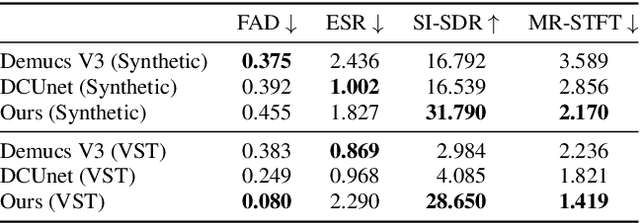

Abstract:Removing audio effects from electric guitar recordings makes it easier for post-production and sound editing. An audio distortion recovery model not only improves the clarity of the guitar sounds but also opens up new opportunities for creative adjustments in mixing and mastering. While progress have been made in creating such models, previous efforts have largely focused on synthetic distortions that may be too simplistic to accurately capture the complexities seen in real-world recordings. In this paper, we tackle the task by using a dataset of guitar recordings rendered with commercial-grade audio effect VST plugins. Moreover, we introduce a novel two-stage methodology for audio distortion recovery. The idea is to firstly process the audio signal in the Mel-spectrogram domain in the first stage, and then use a neural vocoder to generate the pristine original guitar sound from the processed Mel-spectrogram in the second stage. We report a set of experiments demonstrating the effectiveness of our approach over existing methods, through both subjective and objective evaluation metrics.
Distractors-Immune Representation Learning with Cross-modal Contrastive Regularization for Change Captioning
Jul 16, 2024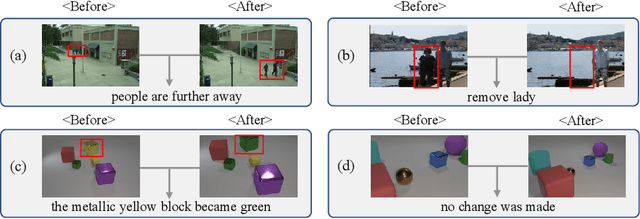
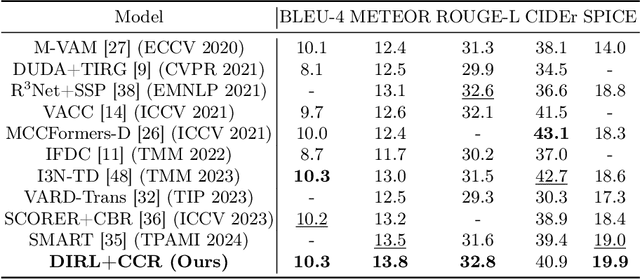
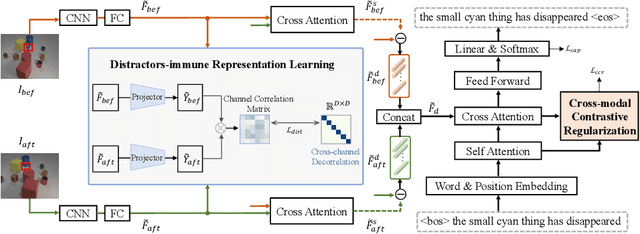
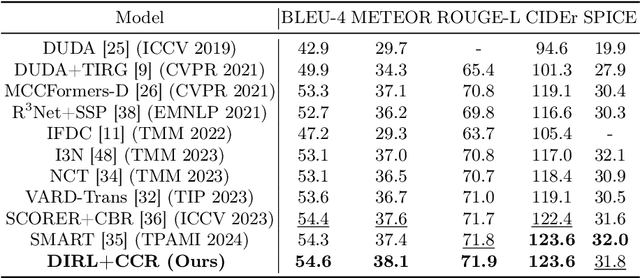
Abstract:Change captioning aims to succinctly describe the semantic change between a pair of similar images, while being immune to distractors (illumination and viewpoint changes). Under these distractors, unchanged objects often appear pseudo changes about location and scale, and certain objects might overlap others, resulting in perturbational and discrimination-degraded features between two images. However, most existing methods directly capture the difference between them, which risk obtaining error-prone difference features. In this paper, we propose a distractors-immune representation learning network that correlates the corresponding channels of two image representations and decorrelates different ones in a self-supervised manner, thus attaining a pair of stable image representations under distractors. Then, the model can better interact them to capture the reliable difference features for caption generation. To yield words based on the most related difference features, we further design a cross-modal contrastive regularization, which regularizes the cross-modal alignment by maximizing the contrastive alignment between the attended difference features and generated words. Extensive experiments show that our method outperforms the state-of-the-art methods on four public datasets. The code is available at https://github.com/tuyunbin/DIRL.
A Study on Synthesizing Expressive Violin Performances: Approaches and Comparisons
Jun 26, 2024



Abstract:Expressive music synthesis (EMS) for violin performance is a challenging task due to the disagreement among music performers in the interpretation of expressive musical terms (EMTs), scarcity of labeled recordings, and limited generalization ability of the synthesis model. These challenges create trade-offs between model effectiveness, diversity of generated results, and controllability of the synthesis system, making it essential to conduct a comparative study on EMS model design. This paper explores two violin EMS approaches. The end-to-end approach is a modification of a state-of-the-art text-to-speech generator. The parameter-controlled approach is based on a simple parameter sampling process that can render note lengths and other parameters compatible with MIDI-DDSP. We study these two approaches (in total, three model variants) through objective and subjective experiments and discuss several key issues of EMS based on the results.
MOSA: Music Motion with Semantic Annotation Dataset for Cross-Modal Music Processing
Jun 10, 2024



Abstract:In cross-modal music processing, translation between visual, auditory, and semantic content opens up new possibilities as well as challenges. The construction of such a transformative scheme depends upon a benchmark corpus with a comprehensive data infrastructure. In particular, the assembly of a large-scale cross-modal dataset presents major challenges. In this paper, we present the MOSA (Music mOtion with Semantic Annotation) dataset, which contains high quality 3-D motion capture data, aligned audio recordings, and note-by-note semantic annotations of pitch, beat, phrase, dynamic, articulation, and harmony for 742 professional music performances by 23 professional musicians, comprising more than 30 hours and 570 K notes of data. To our knowledge, this is the largest cross-modal music dataset with note-level annotations to date. To demonstrate the usage of the MOSA dataset, we present several innovative cross-modal music information retrieval (MIR) and musical content generation tasks, including the detection of beats, downbeats, phrase, and expressive contents from audio, video and motion data, and the generation of musicians' body motion from given music audio. The dataset and codes are available alongside this publication (https://github.com/yufenhuang/MOSA-Music-mOtion-and-Semantic-Annotation-dataset).
Context-aware Difference Distilling for Multi-change Captioning
May 31, 2024Abstract:Multi-change captioning aims to describe complex and coupled changes within an image pair in natural language. Compared with single-change captioning, this task requires the model to have higher-level cognition ability to reason an arbitrary number of changes. In this paper, we propose a novel context-aware difference distilling (CARD) network to capture all genuine changes for yielding sentences. Given an image pair, CARD first decouples context features that aggregate all similar/dissimilar semantics, termed common/difference context features. Then, the consistency and independence constraints are designed to guarantee the alignment/discrepancy of common/difference context features. Further, the common context features guide the model to mine locally unchanged features, which are subtracted from the pair to distill locally difference features. Next, the difference context features augment the locally difference features to ensure that all changes are distilled. In this way, we obtain an omni-representation of all changes, which is translated into linguistic sentences by a transformer decoder. Extensive experiments on three public datasets show CARD performs favourably against state-of-the-art methods.The code is available at https://github.com/tuyunbin/CARD.
 Add to Chrome
Add to Chrome Add to Firefox
Add to Firefox Add to Edge
Add to Edge